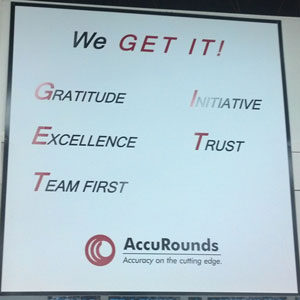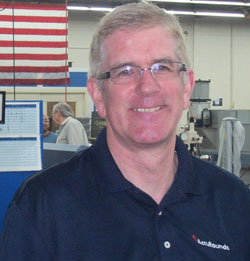|
|
|
Paging Dr. Lean is brought to you by Patricia E. Moody, The Mill Girl at Blue Heron Journal. Submit your Paging Dr. Lean questions to tricia@patriciaemoody.com. |
In the Paging Dr. Lean series, Patricia E. Moody asks lean experts to answer your lean questions. This forum allows industry leaders to speak to the lean issues or questions you come across each day.
Dear Dr. Lean:
We've been steadily implementing lean in our plant for the past three years. We've been pretty successful so far, done the right training and we think we are watching the right numbers. But lately, there have been some outside issues that seem to be impacting our plans.
The economy finally got to us and we've had to postpone some new initiatives. It's made everyone angry and fearful, even though we know we've got great people and we aren't cutting back.
My question to you Dr. Lean is, “Should we start some sort of campaign — maybe do some kaizen events, or some incentives — to take people's minds off what might be happening outside, or make them focus on the work at hand?”
Looking forward to your help,
Wondering in Pennsylvania
Dear Wondering:
I was happy to see in your question the obvious genuine empathy and concern you have for your coworkers. You and your team have achieved a lot in the past three years. However, I am concerned that the current climate in your organization could erode that success very quickly. So, before you embark on incentives or campaigns, I would recommend the following: Take action to change the daily self talk of the organization from blaming to gratitude.
Blaming shuts down our hearts and our creativity. Blaming the economy, blaming the government, blaming the customers, blaming the boss, blaming the company or blaming coworkers. The more we blame, the less control we feel we have.
Gratitude is expansive — it opens the heart. It is easy to find the smallest of things in our daily work to be grateful for. As you introduce gratitude into the daily conversations in your business, you won’t wish for fewer problems (there will always be problems), you will be grateful for the opportunities to be more resourceful, more skillful, more valuable to the team and more innovative.
 For example, when a major customer reengineered a component we had been making for years, we began having multiple quality failures. No matter what changes we made, the process still would not deliver a consistent product. Our team became frustrated and angry — blaming suppliers, internally pointing fingers, blaming management for not increasing the price and even blaming the customer for being “too picky.” When we took a step back and reflected on what we could be grateful for, a number of things appeared.
For example, when a major customer reengineered a component we had been making for years, we began having multiple quality failures. No matter what changes we made, the process still would not deliver a consistent product. Our team became frustrated and angry — blaming suppliers, internally pointing fingers, blaming management for not increasing the price and even blaming the customer for being “too picky.” When we took a step back and reflected on what we could be grateful for, a number of things appeared.
This customer had carried us through some tough economic times, never gave up on us and offered all the technical support they could. By allowing gratitude to enter our daily dialogue, people opened up to the possibilities, to the idea that we could resolve this problem … we could rise to the challenge.
We decided to form a cross-functional team that approached the problem from a different point of view, and that team created a radical new process that produced defect-free parts. It was a big breakthrough for us and gratitude was the key to helping us get above the problem.
Many opportunities will present themselves throughout your work week to move the group from blaming to gratitude. All day long, people make assumptions about other people and the things that go on at work. Those assumptions lead to misunderstandings, which create confusion and anger. Before you know it, you find yourself in the presence of two coworkers who are caught up in blaming and finger pointing.
Step into each new situation you come across with an open and useful attitude, try to lead the conversation with gratitude. It’s not always easy, and you will feel awkward at first.
I recently found myself mediating a disagreement between two colleagues for whom I have the utmost respect. These two individuals are committed to the success of our organization, but they found themselves at an impasse. We introduced gratitude early on into the conversation. There were some awkward silences as we reflected on what they were grateful for, starting with straightforward statements such as “grateful to have a job” and “grateful for my work friends.” But as we pressed on, it was good to hear how much there was to be grateful for (even the smallest of things), and our honest exchange triggered a subtle change in the atmosphere, from antagonistic to open. Although the individuals may not have been ready to be grateful for each other, just then, they were open to the possibility of a resolution. In the end, the disagreement had its roots in misunderstanding. When Jane generated a request for a service, Jack assumed it was required immediately. Jane had not been specific in her request, thinking Jack would know it was not urgent. From Jack’s point of view, here was another “hot” job he had to add to his already full day. We resolved the issue by adding some clarifying words, based on expectations, to their daily interactions. Again gratitude paved the way for a speedy resolution.
As you begin to act your way into this new way of thinking, the team will slowly take your lead. Creating mechanisms that give the team control over what they work on and how they work will support this change. A dynamic suggestion system such as Quick and Easy Kaizen by Norman Bodek (PCS Press) is a fantastic mechanism for recognizing small incremental improvements that employees can make right at their work areas, improvement ideas that are of direct benefit to them, initiated under their control and that add value to the organization. Recognition for the ideas should come in the form of positive immediate feedback with the ideas shared across the rest of the team.
As your team gains more confidence in controlling things inside the organization, and you help facilitate a more positive daily dialogue rooted in gratitude, you will collectively develop a culture that will sustain your improvement gains no matter what the outer conditions.
Stay the course,
Patrick O’Connell
Vice President of Operations at AccuRounds
 Patrick O’Connell is vice president of operations for Avon, MA-based AccuRounds Inc., an advanced manufacturing enterprise providing precision engineered mechanical components and assemblies to aerospace, medical, defense, semiconductor and emerging technology markets. A visionary leader, O’Connell is largely responsible for the implementation of lean strategies and management systems that have resulted in higher efficiency, increased productivity and an enhanced culture of employee alignment and engagement. AccuRounds was the first contract metalworking company in North America to receive the Northeast Shingo Prize Silver Medal.
Patrick O’Connell is vice president of operations for Avon, MA-based AccuRounds Inc., an advanced manufacturing enterprise providing precision engineered mechanical components and assemblies to aerospace, medical, defense, semiconductor and emerging technology markets. A visionary leader, O’Connell is largely responsible for the implementation of lean strategies and management systems that have resulted in higher efficiency, increased productivity and an enhanced culture of employee alignment and engagement. AccuRounds was the first contract metalworking company in North America to receive the Northeast Shingo Prize Silver Medal.
As a passionate advocate for U.S. manufacturing and enterprise excellence, he has been featured on NPR and in several lean manufacturing education videos. Active within industry groups, including AME, he has presented on various aspects of AccuRound’s lean deployment. He continues his executive education daily and is enrolled in the MIT Sloan School of Management, Executive Education Program.
Note: For a video on gratitude, see Barrett Ersk at the EO Alchemy Conference 2011.
Named by Fortune magazine a "Pioneering Woman in Manufacturing," Patricia E. Moody, The Mill Girl at Blue Heron Journal, tricia@patriciaemoody.com, is a business visionary, author of 14 business books and hundreds of features. A manufacturing and supply management consultant for more than 30 years, her client list includes Fortune 100 companies as well as start-ups. She is the publisher of Blue Heron Journal, where she created the Made In The Americas (sm), the Education for Innovation (sm) and the Paging Dr. Lean series. Her next book about the future of manufacturing is The Third Industrial Revolution. Copyright Patricia E. Moody 2013. All rights reserved.



